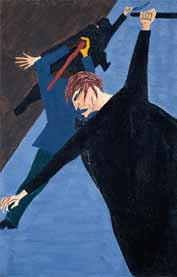|
|
 |
 |
 |

Click here to view a larger image |
Race riots
were very numerous all over the North because of the antagonism that
was caused between the Negro and white workers. Many of these riots
occurred because the Negro was used as a strike breaker in many of
the Northern industries.
The Migration of the Negro, panel
50, 1940-41. Casein tempera on hardboard 18 x 12 in. (45.7 x 30.5
cm), The Museum of Modern Art, New York; gift of Mrs. David M. Levy
Artwork © Gwendolyn Knight Lawrence, courtesy of the Jacob and
Gwendolyn Lawrence Foundation |
| |
|
 |
 indicates a link to another site
indicates a link to another site
Many white workers in the North feared the competition for jobs that
was created by the migration of blacks from the South. Not only did
black workers compete against white workers for jobs on a day-to-day
basis, but blacks were often used as strikebreakers during strikes
organized by white labor unions. In some cases, blacks did not realize
that they were being brought in as strikebreaker,s and would sometimes
quit upon learning the circumstances. In other cases, blacks were
so desperate for work that they deliberately chose to migrate to certain
cities where they knew they could be hired as strikebreakers.
In 1917, when an aluminum plant in East St. Louis hired black workers
during a strike, white workers rioted, terrorizing blacks on the street
and setting fire to black homes. Racial antagonisms, resulting indirectly
from the labor competition caused by the Great Migration, continued
to cause riots throughout the country during what was known as the
 "Red
Summer" of 1919. "Red
Summer" of 1919.
In this painting, Jacob Lawrence pared down the composition and used
diagonal shapes and movements to heighten the impression of action
and create a powerful visual statement. Lawrence also emphasized the
central figure's physical gesture by stretching his arms across the
picture plane, partially blocking visual access into the scene. |
|
|

• What is a  riot?
riot?
Find out if anyone in your family has been in a riot, a demonstration, or
a strike. Interview them about their memories of this experience. Even if
they were not directly involved in such an incident, they will probably
have memories of a notorious riot or strike. After conducting your interview,
share it with your classmates. Are there differing accounts of specific
strikes or riots? What might account for these differences? |









